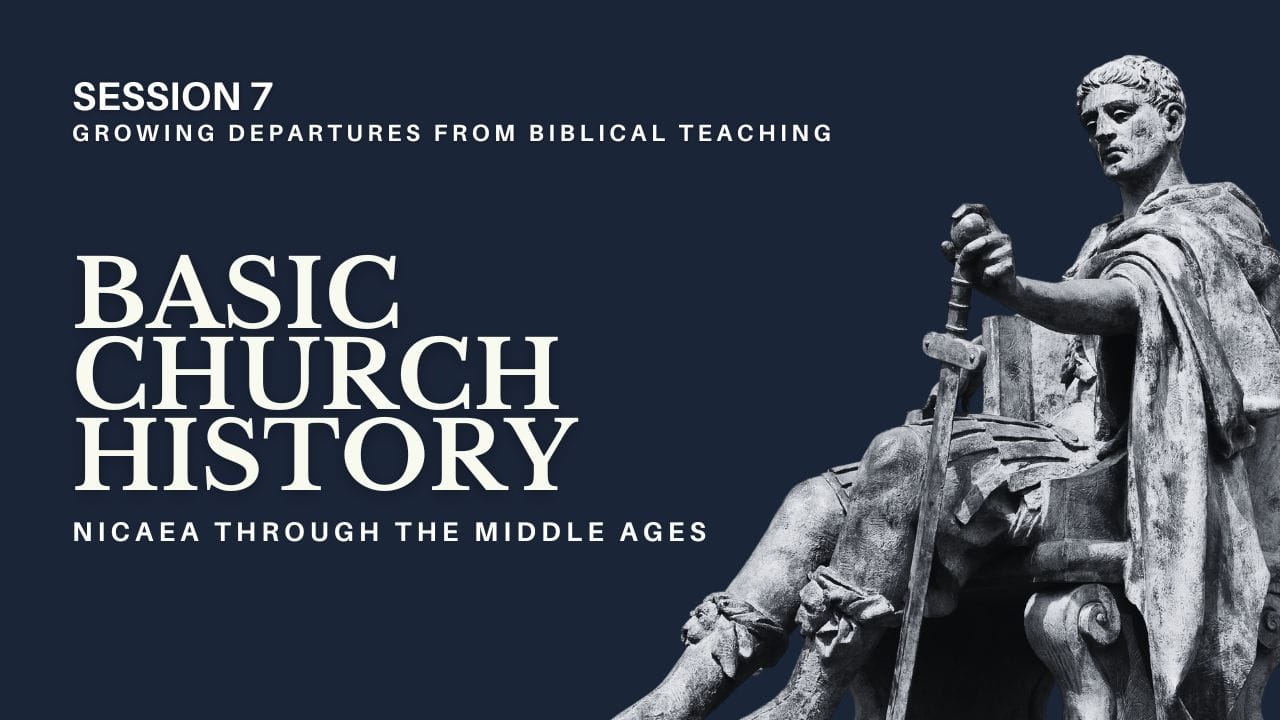Sunday School Review: Basic Church History: Nicaea through the Middle Ages, Part 7
Welcome to today’s review of the material covered in our seventh session: early departures in church practice from biblical teaching.

The period between 100 and 461 AD is especially formative in the history of the Christian church. Emerging from its status as a persecuted minority to become the official religion of the Roman Empire, the church underwent significant (and, at times, unbiblical) transformations. While this era saw the defense of key doctrines and the perseverance of the faithful under immense pressure, it also witnessed the emergence of practices that, from a Protestant evangelical perspective, marked a deviation from the authority of Scripture.
Many of these practices arose from noble intentions—seeking to honor God, foster devotion, and encourage holiness. Yet, when the church elevates human tradition above biblical teaching, even well-meant innovations can obscure the gospel and lead to distortion. As we review these historical developments, we do so with a spirit of humility and love, praying for continued reformation and unity in Christ’s church according to His Word.
If you’re new here and missed last week's review, you can find it here.
Prayers for the Dead and Purgatory
Prayers for the dead appeared as early as the late second century, rooted in the desire to intercede for the departed. Early theologians such as Tertullian and Cyprian mentioned prayers for the deceased, suggesting they could assist those who had died in imperfect repentance. This practice was likely influenced by pagan and Jewish customs that emphasized rituals for the afterlife.
The related doctrine of purgatory began to develop in this era, though it would not be fully articulated until later. Augustine of Hippo, while emphasizing the sufficiency of Christ’s work, speculated about an intermediate state where lesser sins might be purified. The foundation for purgatory lay in an allegorical reading of passages like 1 Corinthians 3:15, where Paul speaks of being “saved, but only as through fire.”
Though well-intentioned, these practices distorted the biblical teaching on salvation. Scripture is clear that Christ’s sacrifice is fully sufficient for the believer’s sanctification and justification (Hebrews 10:14). By suggesting that human actions—whether prayers or posthumous purification—could contribute to salvation, these innovations undermined the finished work of Christ on the cross.
Lent and Mandatory Fasting
The forty-day Lenten season evolved gradually, beginning with early Christian fasting practices. Initially, fasts were short and tied to specific events such as Easter. By the fourth century, this observance extended to forty days, echoing Christ’s fasting in the wilderness (Matthew 4:2). This period of preparation for Easter was seen as a time for self-denial and reflection.
While fasting is a biblical practice, its institutionalization as a mandatory observance shifted its focus from voluntary devotion to legalistic requirement. Over time, Lent became less about personal spiritual growth and more about external conformity. This shift echoes Paul’s warning in Colossians 2:20–23 against imposing human traditions that “have an appearance of wisdom” but lack the power to transform the heart.
The Lord’s Supper as a Sacrifice
One of the most significant theological developments of this period was the understanding of the Lord’s Supper as a repeated sacrifice. Early Christians viewed the Eucharist as a sacred meal commemorating Christ’s death, but by the fourth century, language describing it as a sacrificial offering became prominent. Church leaders like Ambrose and Chrysostom referred to the Eucharist as a continuation of Christ’s sacrifice, reflecting an attempt to connect worship with Christ’s atoning work.
While this language may have been intended to highlight the significance of the Lord’s Supper, it strayed from the New Testament’s teaching. Hebrews 10:10–14 repeatedly emphasizes that Christ’s sacrifice was offered “once for all.” The notion of a recurring sacrifice obscures this truth, leading to confusion about the sufficiency of Christ’s atonement and the believer’s assurance of salvation.
Clericalism and the Division of Laity and Clergy
As the church gained institutional structure, the role of clergy became increasingly distinct from the laity. Bishops, presbyters, and deacons—offices rooted in the New Testament—took on expanded roles as mediators of God’s grace. By the fifth century, the clergy were viewed as indispensable intermediaries, administering sacraments and holding authority over spiritual matters.
This clericalism was influenced by Roman hierarchical systems and Old Testament priesthood imagery. Yet, it diverged from the New Testament teaching that all believers are part of a “royal priesthood” (1 Peter 2:9). The sharp division between clergy and laity undermined the church’s collective identity as the body of Christ, where every member has a role to play (1 Corinthians 12:12–27).
The Veneration of Mary, Saints, and Relics
The veneration of martyrs and the growing honor given to Mary emerged from a sincere desire to celebrate faithfulness and highlight God’s work in their lives. By the fourth century, however, these practices took on excessive forms. Martyrs were honored with elaborate feasts and shrines, and relics—physical remains or objects associated with saints—were believed to possess miraculous powers.
Mary, the mother of Jesus, was increasingly exalted as an object of devotion. Prayers addressed to Mary and titles such as “Mother of God” (Theotokos) reflected a desire to affirm the full deity of Christ but also introduced practices that diverted worship from Christ Himself.
Scripture consistently directs worship to God alone. While we honor faithful believers and the extraordinary role of Mary in God’s redemptive plan, practices such as relic veneration and prayers to saints risk idolatry and undermine Christ’s role as the sole mediator between God and humanity (1 Timothy 2:5).
Ritualism and the Decline of Preaching
The growing splendor of church rituals and the use of elaborate vestments for clergy reflected an effort to inspire reverence. Liturgical practices became increasingly complex, with dramatic ceremonies and symbolic gestures replacing the simple worship described in the New Testament.
Unfortunately, this shift often displaced the preaching of God’s Word. Whereas the apostles emphasized the proclamation of Scripture as central to the church’s mission (Acts 6:2–4; 2 Timothy 4:2), this period saw a diminishing focus on teaching. The rituals, while visually striking, lacked the innate and transformative power of God’s Word (Romans 10:17).
Pilgrimages and Monasticism
The practice of pilgrimage, though inspired by a desire for spiritual renewal, often reflected a misunderstanding of the means of grace. Believers traveled to holy sites, seeking physical proximity to relics or locations associated with Christ and the saints. These journeys, while deeply meaningful for some, suggested that God’s presence was confined to specific places rather than being accessible to all believers through Christ.
Monasticism emerged as a reaction to the growing worldliness of the church. Monks and nuns sought holiness through withdrawal from society, dedicating themselves to prayer and asceticism. While their zeal was commendable, monasticism often promoted an unbiblical separation from the world, contrary to Jesus’ prayer that His followers be in the world but not of it (John 17:15–18).
Conclusion
From a Protestant evangelical perspective, the developments of this period illustrate the danger of departing from Scripture as the ultimate authority for faith and practice. Many of these innovations—prayers for the dead, purgatory, relic veneration, and excessive ritualism—arose from sincere motives but obscured the simplicity of the gospel.
Yet even in this era, God preserved His truth. Faithful believers upheld the authority of Scripture and the sufficiency of Christ’s work. These seeds of biblical fidelity would later blossom in the Reformation, which sought to call the church back to its foundation in God’s Word.
We reflect on this history with both conviction and compassion. While we reject these practices as deviations from Scripture, we affirm our love for every expression of the Body of Christ, praying for the continued reformation of the church. True unity must be grounded in the supreme authority of God’s Word and the gospel of grace through faith in Christ alone.
As heirs of the Reformation, we are called to uphold the purity of the gospel and proclaim the sufficiency of Christ’s finished work. May this history serve as a reminder to stand firm in Scripture, labor for unity in truth, and pray for the renewal of Christ’s church to His glory.
Questions for Review
- Practices such as prayers for the dead and the doctrine of purgatory emerged during this period and later became central to Roman Catholic theology. How can we thoughtfully evaluate such practices in light of Scripture, especially passages like Hebrews 10:14 and 2 Corinthians 5:8?
- The institutionalization of Lent and mandatory fasting shifted the focus of spiritual disciplines from voluntary devotion to legal obligation. How might this development serve as a caution for how we approach spiritual disciplines in our own churches today?
- The veneration of Mary, saints, and relics became widespread during this time, shaping both theology and worship practices. What safeguards can help ensure that we honor faithful believers without diminishing Christ’s role as the sole mediator between God and humanity (1 Timothy 2:5)?
- The rise of monasticism reflects an effort to pursue holiness in a world perceived as increasingly worldly. While acknowledging its historical influence, how can we maintain a biblically faithful balance between being “in the world but not of it” (John 17:15–18) in our own time and context?
- During this era, the Lord’s Supper began to be viewed as a repeated sacrifice, while the Roman Catholic tradition later expanded the sacraments to seven. In contrast, evangelical churches affirm baptism and the Lord’s Supper as ordinances instituted by Christ. How can we rightly emphasize the centrality of God’s Word in worship while maintaining a proper, biblically grounded understanding and practice of these ordinances?
Resources
Bruce L. Shelley, Church History in Plain Language (Nashville: Thomas Nelson, 1995).
Justo L. González, The Story of Christianity, Vol. 1: The Early Church to the Dawn of the Reformation (New York: HarperCollins, 1984).
B.K. Kuiper, The Church in History (Grand Rapids:L Wm. B. Eerdmans Publishing Company, 2001).
Unless otherwise indicated, all Scripture quotations are from The ESV® Bible (The Holy Bible, English Standard Version®), © 2001 by Crossway, a publishing ministry of Good News Publishers. Used by permission. All rights reserved.
